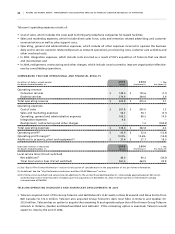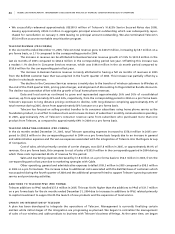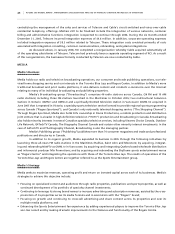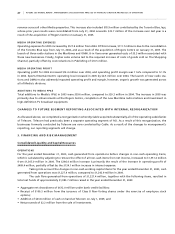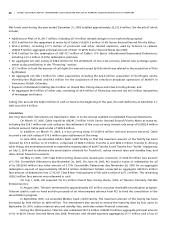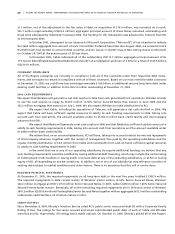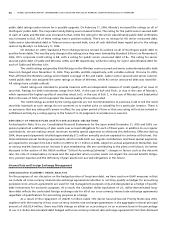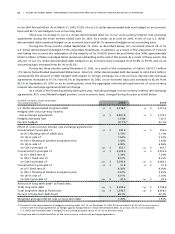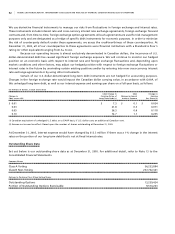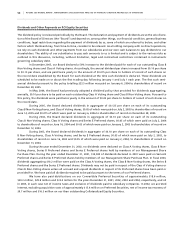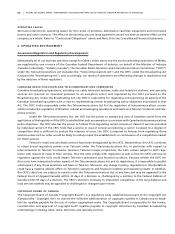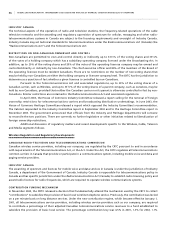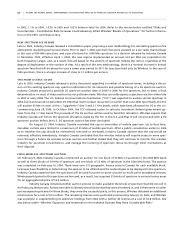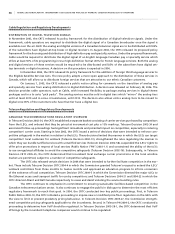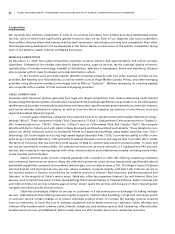Rogers 2005 Annual Report Download - page 56
Download and view the complete annual report
Please find page 56 of the 2005 Rogers annual report below. You can navigate through the pages in the report by either clicking on the pages listed below, or by using the keyword search tool below to find specific information within the annual report.
52 ROGERS 2005 ANNUAL REPORT . MANAGEMENT’S DISCUSSION AND ANALYSIS OF FINANCIAL CONDITION AND RESULTS OF OPERATIONS
We use derivative financial instruments to manage our risks from fluctuations in foreign exchange and interest rates.
These instruments include interest rate and cross-currency interest rate exchange agreements, foreign exchange forward
contracts and, from time-to-time, foreign exchange option agreements. All such agreements are used for risk management
purposes only and are designated as a hedge of specific debt instruments for economic purposes. In order to minimize
the risk of counterparty default under these agreements, we assess the creditworthiness of these counterparties. At
December 31, 2005, all of our counterparties to these agreements were financial institutions with a Standard & Poor’s
rating (or other equivalent) ranging from A+ to AA.
Because our operating income is almost exclusively denominated in Canadian dollars, the incurrence of U.S.
dollar-denominated debt has caused significant foreign exchange exposure. We will continue to monitor our hedged
position on an economic basis with respect to interest rate and foreign exchange fluctuations and, depending upon
market conditions and other factors, may adjust our hedged position with respect to foreign exchange fluctuations or
interest rates in the future by unwinding certain existing positions and/or by entering into new cross-currency interest
rate exchange agreements or by using other instruments.
Certain of our U.S. dollar-denominated long-term debt instruments are not hedged for accounting purposes.
Changes in the foreign exchange rate would impact the Canadian dollar carrying value, in accordance with GAAP, of
this unhedged long-term debt, as well as our interest expense and earnings per share on a full-year basis, as follows:
(In millions of dollars, except share data)
Cdn$ Change in Cdn$ Change in
Change in Carrying Value of Change in Annual Earning
Cdn$ versus US$ Long-Term Debt (1) Interest Expense Per Share (2)
$ 0.01 $ 7.3 $ 0.1 $ 0.024
0.03 21.8 0.3 0.071
0.05 36.3 0.6 0.118
0.10 72.7 1.1 0.235
(1) Canadian equivalent of unhedged U.S. debt, on a GAAP basis, if U.S. dollar costs an additional Canadian cent.
(2) Assume no income tax effect. Based upon the number of shares outstanding at December 31, 2005.
At December 31, 2005, interest expense would have changed by $13.3 million if there was a 1% change in the interest
rates on the portion of our long-term debt that is not at fixed interest rates.
Outstanding Share Data
Set out below is our outstanding share data as at December 31, 2005. For additional detail, refer to Note 13 to the
Consolidated Financial Statements.
Common Shares
Class A Voting 56,233,894
Class B Non-Voting 257,702,341
Options to Purchase Class B Non-Voting Shares
Outstanding Options 13,239,424
Portion of Outstanding Options Exercisable 9,570,203



